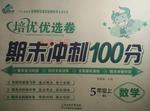题目内容
In Paris there is a popular saying _______ you have not been to Paris if you haven't been to the Eiffel Tower.
- A.which
- B.why
- C.that
- D.whether
C
that引导同位语从句,说明saying的内容。
that引导同位语从句,说明saying的内容。

练习册系列答案
 通城学典默写能手系列答案
通城学典默写能手系列答案 金牌教辅培优优选卷期末冲刺100分系列答案
金牌教辅培优优选卷期末冲刺100分系列答案
相关题目